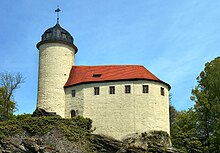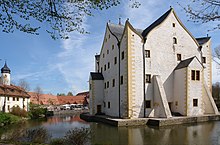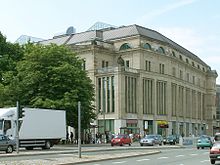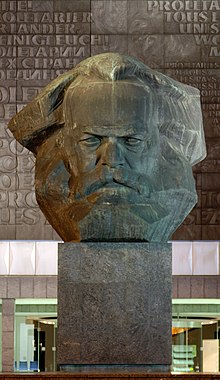Sights in Chemnitz
Despite war damage, Chemnitz offers a number of buildings worth seeing from many eras. The Red Tower , which was part of the historic city fortifications, is considered the oldest building . Some lavishly restored half-timbered houses at the foot of the Schloßberg date from the 16th century . The only Baroque facade to be mentioned is the Siegertsche House, built by Johann Christoph von Naumann on the market between 1735 and 1741 . In 1909, the city planner Richard Möbius created the opera house and the König-Albert-Museum (both on Theaterplatz ) as well as the main fire station on Schadestrasse. Not far from the city center is one of the largest preserved Wilhelminian style and Art Nouveau quarters in Europe on the Kaßberg . To the northeast of the city center, the Stadtbad was built by Fred Otto from 1928 to 1935 ; it is an important monument of architectural modernism . The clock tower built in 1927 by the Schubert & Salzer company by Erich Basarke , also known as the “Wirkbau” tower, rises out of town towards the south on the left of the Chemnitz . The water Klaffenbach and Burg Rabenstein are visiting.
Historic buildings
Red Tower
The Red Tower is probably the most striking monument from the medieval history of Chemnitz. Its quarry stone base probably dates from the late 12th or early 13th century. During systematic investigations in 1957/58 it was found that the city wall is younger than the tower and that it is connected to it. In 1555, the upper floor was made of brick with Gothic facing architecture. The tower served for a long time as a town front festival, in 1957/58 it was rebuilt and set up as a museum.
Old Town Hall
The late Gothic old town hall was built between 1496 and 1498 on the site of the previous wooden buildings and was later rebuilt several times. During the Second World War it burned out except for the vaults on the first floor and was increased by one floor during the reconstruction. Which is located at the front of the City Hall tower Judith - Lucretia portal from 1559, which was attached to the side from destruction. The older high tower , which was probably part of an inner-city fortification from around 1200, belongs to the town hall complex . The tower collapsed on the night of February 3rd to 4th, 1946. The ruins were initially blown up, but the tower was later rebuilt.
new town hall
The New Town Hall was built between 1907 and 1911 based on a design by the City Building Councilor Richard Möbius. The portal from the end of the 14th century comes from the old Latin school, which was then abandoned. The front has not been cleaned since then in memory of fires from World War II.
Siegert's house
The Siegert House with a magnificent baroque facade stands on the market square . It was built between 1737 and 1741 according to plans by Johann Christoph von Naumann . After the destruction in World War II, only the middle baroque facade was preserved and was rebuilt in 1953/1954.
Arched walkways in the Kaßberg
Nothing is known about the origin of the vaulted passages in the Kaßberg , which are located on Fabrikstrasse on the eastern steep slope of the Kaßberg. In any case, they have been used since the early 16th century in particular to store the heavily hopped heavy lager (bottom-fermented beer). Not far from the old mountain cellars , which were used as air raid shelters in World War II, is the beer bridge , which also reminds of this time. Since January 15, 1999, the vaulted passages have been open to visitors and residents of the city. Cabaret evenings and live music events also invite you to visit.
Rabenstein Castle
The Rabenstein Castle , the smallest castle in Saxony. The castle was built in the 2nd half of the 12th century. The first owners were imperial ministerials . In 1375 the castle came into the possession of the Chemnitz Benedictine monastery and became sovereign property during the Reformation. In 1619 the electoral forester Hans Georg von Carlowitz acquired the castle and redesigned it in a baroque style. From 1774 the castle belonged to Johann Georg Siegert , a Chemnitz textile entrepreneur. His son-in-law Johann Georg von Welck redesigned the castle in the Romantic style at the beginning of the 19th century. After that, the castle changed hands several times and after the Second World War it became the property of the municipality of Rabenstein. Rabenstein Castle has belonged to the Chemnitz museums since 1950. The castle can be visited from April to October.
Klaffenbach moated castle
The moated castle Klaffenbach is located south of Chemnitz and represents an example of a moated castle from the Renaissance that is almost unique in Saxony .
Einsiedler brewery
The Einsiedler Brauhaus, built in 1885 in the Einsiedel district of Chemnitz, is located in the south of the city. The historic brewery building was founded by the machine manufacturer Emil Schwalbe and is still one of the most emblematic buildings in the district.
Villas
Important villa buildings in Chemnitz are the Art Nouveau villas Villa Esche (built in 1903, expanded in 1911) and Villa Körner (1914) , based on plans by Henry van de Velde .
Chemnitz city baths
The Stadtbad Chemnitz on Mühlenstrasse, which opened in 1935 and was built from 1928 according to plans by the town planning officer Fred Otto , was one of the most modern swimming pools in Europe. It includes, among other things, a sports and a school swimming pool. Opposite is the relocated birthplace of Fritz Heckert (today "Heck-Art", restaurant and gallery).
DAStietz cultural department store
The adult education center, the city library and the Museum of Natural History with the Petrified Forest are housed in the former Tietz department store (“ DAStietz ” cultural department store since 2004 ) on Bahnhofstrasse . Not far from the “Tietz” is the former Schocken department store, which opened in 1930 and was built according to plans by Erich Mendelsohn , in the direction of the main train station on Brückenstraße . During the GDR era, both houses were used by the “Centrum-Warenhaus” group and then by the “Kaufhof” chain. Since 2014, the “Schocken” has housed a nationally significant archeology museum, the smac .
Modern architecture (post-war architecture)
Karl Marx Monument
In addition to the Hotel Kongress , the old and new town hall on the market square and the Fritz Heckert prefabricated building area, Chemnitz is primarily known for the Nischel or Nüschel ( Saxon dialect for head ). The massive Karl Marx Monument by the Russian artist Lew Kerbel , inaugurated in 1971 and a symbol of the city of Chemnitz, is located in front of the buildings on Brückenstraße (Karl-Marx-Allee) 10/12. During the GDR era, these served as the headquarters of the district council and the SED district leadership. At house number 10 there is a huge blackboard with the sentence from the Communist Manifesto “Workers of all countries unite!” In German , English , French and Russian . After the political change in 1989, u. a. the Labor Office and the regional board accommodated therein. Today there are still other state authorities, e.g. B. the State Office for Taxes and Finances.
The new Chemnitz
Since during the last two decades of the GDR era construction production was concentrated on creating living space, the plans for a model socialist inner city remained unrealized. Since 1990 there have been initial plans to further densify the city center of Chemnitz. These were implemented from the end of the 1990s. The city administration of Chemnitz uses the resulting buildings for city marketing purposes under the slogan "The 'new' Chemnitz".
The “new” city center of Chemnitz was created according to plans by internationally renowned architects such as Helmut Jahn , Hans Kollhoff and Christoph Ingenhoven . Of them, the glass comes Kaufhof and glass department store "Peek & Cloppenburg" and the gallery "Red Tower". The Türmer building is also included, as are the Rosenhof arcades and the middle class mile with its construction sections one and two - also known as the town hall arcades.
The new branch of the regional central bank of the Deutsche Bundesbank at the Park of the Victims of Fascism is the work of the Spanish architect Josep Lluís Mateo . It is an introverted structure, the street facade of which has been clad in travertine stone . The facade makes references to the petrified forest, but the building is more famous for the structural damage caused by water entering the translucent facade.
The cultural department store "DAStietz" is a former department store ( Wilhelm Kreis , 1913), which today houses the city library, the adult education center, the Museum of Natural History and the New Saxon Gallery. The Petrified Forest is located in the large atrium .
The new synagogue on Stollberger Strasse was designed by the architect Prof. Alfred Jacoby and was consecrated on May 24, 2002. During the pogrom of November 9-10, 1938, the old Chemnitz synagogue (built 1897–1899 according to plans by architect Wenzel Bürger) on Stephanplatz was set on fire and damaged, as was 2,000 other Jewish places of worship in the German Empire . The rubble removal was completed on November 15 of that year.
The Chemnitz Arena is a multi-purpose hall with up to 13,000 standing or 7,000 seats. It was one of many former production halls on the site of the former Wanderer works . There are two turbine test stands in front of the hall, which were secured by the monument protection authorities.
The Solaris tower on the site of the former Fettchemie is a striking and widely visible office and service complex with an integrated petrol station as well as in the vicinity of a fully automated parking garage, which was demolished in 2006 due to a lack of demand.
The construction projects not implemented after reunification in the early phase of the new planning for the city center of Chemnitz include the Conti-Galerie and the Maison de France. Foundation work was carried out for the Conti gallery, but it was not completed. This is where the area popularly known as the “ Conti-Loch ” is located today . The Maison de France was planned near Falkeplatz next to the historic Deutsche Bank building.
Tallest structures
With a height of 302 m, the chimney of the combined heat and power plant north is the tallest structure in the city and the tallest structure in Saxony.
The tallest building, 97 m high, is the “Kongress” hotel (now “Mercure”) in the city center, built in 1974. This is followed by the town hall complex.
At 88 m, the double-helmeted tower of the Markuskirche (based on designs by the Berlin architects Abesser and Kröger , consecrated in 1895) is the highest church tower on the Sonnenberg and a striking landmark on the Sonnenberg.
The first high-rise in Chemnitz was the building of the former upholstery weaving mill Cammann & Co. , which still exists today, with a height of 40 m; It was built in 1925/1926 in Chemnitz-Furth based on a design by the architect Willy Schönefeld.
In terms of architecture, the city center of Chemnitz is characterized by the remains of older buildings and, above all, by buildings in the style of socialist realism and, since 1990, by steel and glass. Last but not least, Chemnitz is home to one of the largest Wilhelminian style and Art Nouveau quarters in Europe, the Kaßberg . The comparatively few older objects that were spared the destruction of the Second World War are also worth seeing.
Sacred buildings
The town church of St. Jacobi is the only preserved medieval church building intra muros (within the city walls) and the oldest preserved church. The late Gothic three-aisled nave dates from the second half of the 14th century, the ambulatory choir from the beginning of the 15th century. The facade was redesigned in the 19th and early 20th centuries (1911). The church was badly damaged in World War II (the nave collapsed, the choir was preserved) and was poorly rebuilt in the years that followed. The reconstruction of the original vault lasted from 1997 to 2009.
The Johanniskirche was one of the first sacred buildings in the area around the old town center. The church consecrated to John the Baptist was first mentioned in a document in 1264. Due to its location outside the city wall, the wooden church, which was built in wood until 1566, was destroyed several times during sieges of the city and rebuilt. In 1866 the church was given its current shape, in 1878 a 44 m high tower, which was modified in 1912/13 according to designs by Zapp & Basarke and did not survive the air raids of World War II. It was dismantled in 1970 and given a pyramid roof at a height of 23 m . The Johannisfriedhof , which was used as the city cemetery until 1874, was called Karl-Marx-Platz from 1928 to 1933 and 1945 to 1974 and since the Park of the Victims of Fascism . Even today there are graves of Chemnitz citizens (including Christian Gottfried Becker ) and soldiers who died in the war of 1870 in the park . A Johanniskirche is still in the Reichenbrand district at the intersection of Zwickauer Strasse and Hohensteiner Strasse .
A remnant of the former Benedictine monastery is the castle church on the Schloßberg , a late Gothic hall church and successor to a Romanesque basilica from 1136. It is followed by the Schloßbergmuseum Chemnitz . The castle church has been rebuilt several times since its construction (1499–1525) on a previous building from the 12th century in connection with the Chemnitz monastery. Some buildings have since been demolished after the conversion to an electoral palace (from 1548), the south wing has housed the Schloßberg Museum since 1930/1931.
In the immediate vicinity of the castle church, on the southern slope of the castle hill, there are several half-timbered houses that have been preserved from the 17th century and were recently converted into gastronomic facilities.
The Petrikirche , a neo-Gothic sandstone building, which was designed by Hans Enger and consecrated in 1888, stands between the Theaterplatz and Schillerplatz . Opposite you are the Chemnitz Opera House and the King Albert Museum.
There are three churches on the Kaßberg. The Kreuzkirche by Otto Bartning (1936) on Henriettenstrasse , the Friedenskirche from 1879, which houses a Methodist congregation, and the Trinity Church - both on Kaßbergstrasse. On the southern slope of the Kaßberg on Hohe Straße is the Catholic provost church of St. Johannes Nepomuk, which was designed by the architect Willy Schönefeld.
The Markuskirche is one of two churches on the Sonnenberg. The neo-Gothic brick church with a double helm tower dates from 1895. In 1905, the construction of the St. Joseph Church was completed for the Catholic community.
The Luther Church on Zschopauer Straße was built according to the plans of the Berlin architect Otto Kuhlmann between 1905 and 1909 and was one of the first buildings in Chemnitz to be constructed using reinforced concrete. Churches of the same name can be found in the districts of Harthau and Schönau.
An old collegiate church is embedded in the old village center of the Ebersdorf district . It was a place of pilgrimage for the Saxon Elector Frederick the Meek and his wife Margaretha. In connection with the Saxon prince robbery , they left behind the clothes of the kidnapped princes Ernst and Albert. The Peter-Pauls-Kirche in Mittelbach is a successor to a Romanesque chapel from the 14th century. After several renovations and the last restoration, it is one of the smallest churches in the city.
Other churches worth seeing are the St. Matthew Church in Altendorf, the St. Michaelis Church in Altchemnitz, the Gnadenkirche in Borna , the St. Andreas Church (1888) in Gablenz, the St. Jodokus Church in Glösa, the church on Harthauer Kirchsteig , the Trinitatiskirche in Hilbersdorf, the St. Georg Church in Rabenstein, the Christ Church in Reichenhain , the Jacobikirche in Einsiedel, the Kreuzkirchen in Grüna and Klaffenbach as well as the churches in Adelsberg, Euba, Kleinolbersdorf-Altenhain , Röhrsdorf and Wittgensdorf.
Places
Theater square
City planner Richard Möbius created the ensemble on Theaterplatz between 1906 and 1909 . According to his designs, the King Albert Museum and the Chemnitz Opera House were built directly adjacent to the St. Petri Church , which was built in 1885–1888 . Opposite the museum, in the place of the Hotel Chemnitzer Hof , which opened in 1928, was a fountain with Schilling's figures , which are now in the castle pond park. To the north of the Theaterplatz is the Schillerplatz . Opposite it, the building of the former royal trade school was built in 1836 , which is now part of the Chemnitz University of Technology .
Falkeplatz
The Falkeplatz is located southeast of Chemnitz city center . In place of the former Nikolaivorstadt is the Deutsche Bank AG building, built between 1922 and 1924 according to plans by Erich Basarke . This building was used by the State Bank of the GDR during the GDR era and was also the district headquarters and district branch of Karl-Marx-Stadt. The Sparkasse skyscraper was built between Stollberger Strasse and Zwickauer Strasse in 1930 and was converted into the Gunzenhauser Museum after 2000 .
Not far from Falkeplatz, the building of today's fire station was erected on Schadestrasse under the direction of Richard Möbius . Opposite it was the municipal loan office in the Aue , the building of which has been used by the Karl-Marx-Städter / Chemnitz city archive since 1953.
More Attractions
- The Petrified Forest in the "DAStietz" cultural department store
- The castle pond and the Schilling figures
- The Rosenhof
- The gallery above
- The Chemnitz Zoo
- Küchwaldpark with the Sigmund Jähn Cosmonaut Center and the Park Railway
- The city park along the Chemnitz
- Waterworks park on the Zwönitz
- Show mine "Felsendome Rabenstein"
- Wildgatter Oberrabenstein
- Chemnitz Botanical Garden (School Biology Center)
- Arctic-Alpine garden of the Walter Meusel Foundation
- The garden city Gablenzsiedlung (first garden city in Chemnitz)
- Chemnitz Industrial Museum
- Museum for Saxon Vehicles in the historic Stern garages
- The former Kulturpalast (monumental neoclassical style - first Kulturpalast of the GDR )
- The longest circular route around Chemnitz is approx. 60 km; He touches many sights
- Zeisigwaldschänke , also known as 'Old Witch House' designated
- Wachtelberg, where many legends should have played (accessible via the west-east hiking trail), Galgenberg, on which executions took place in the Middle Ages
- Adelsberg Tower and the Black Forest





















